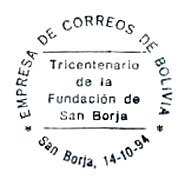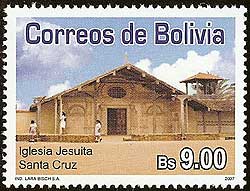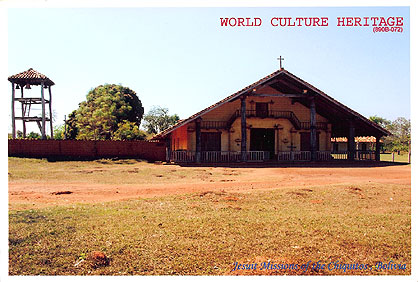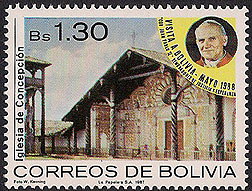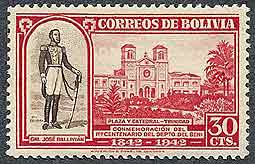Colegio San Inacio, La Paz

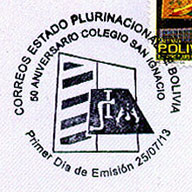
BOLIVIA, 2013, for the 50th anniversary of the college, Scott 1565
When the Jesuits returned to Bolivia after the Suppression, Bishop Callistus Clavijo, donated facilities in La Paz where the first Jesuit school in Bolivia, named Colegio San Callisto in honor of the bishop, began in 1882. Inspired by this work and wishing to expand the educational effort, in the late 1940s students acquired land near Seguencoma, and in 1963, a new school began, San Calixto of Seguencoma. In 1970 Father Antonio Villalba came to Seguencoma and established the Colegio Loyola as an evening school, and to assure its separate administration he created the Educational Community of Seguencoma Limited (CESEL) administered by parents and independent professionals, as well as a Student Council to allow students to participate in the activities of the board of directors. In 1981, the two schools were merged into a single service called "San Ignacio," operating both during the day and in the evening. In 2002 The Society of Jesus concluded an agreement with CESEL, and since 2003, the Jesuits in Bolivia have assumed all responsibility for the Colegio San Ignacio. In December of 2002 the Educational Foundation Father Pedro Arrupe (FEPPA) was formed to harmonize the management of the Jesuit Schools: Colegio San Ignacio, Colegio San Calixto, and the Colegio del Sagrado Corazón in Sucre.


BOLIVIA, 1989, the 50th anniversary of Radio
Fides, Scott 787 and its FDI cancel
This stamp bears prominently the seal of the Society of Jesus. Licensed around 1937, Radio Fides, operated by the Jesuits out of La Paz, is the second oldest Catholic radio in the Americas, the third oldest in the world.

BOLIVIA, 1994, the tercentenary of San Borja, Scott 920 and its FDI cancelSan Borja, the mission and town in the Department of Beni, Bolivia, was founded as San Francisco de Borja by Jesuit missionaries Francisco Borja and Ignacio de Sotomayor, on October 10th, the feast of St. Francis Borgia, SJ, 1693 on the banks of Maniqui river, just 23 years after Borgia's canonization.
Jesuit Missions of the Chiquitos
The Church of San Rafael de Velasco
ANTIGUA & BARBUDA, 1997, a souvenir sheet celebrating the 50th anniversary of UNESCO, features five Jesuit institutions including the Jesuit Missions of the Chiquitos, Scott 2054dThe Jesuit Missions of the Chiquitos are in the Santa Cruz department of eastern Bolivia. Six of them have been designated a UNESCO World Heritage Site: San Javier and Santa Ana de Velasco (which are featured on the issue below), San José de Chiquitos, Conceptión (see below), San Miguel de Velasco, and San Rafael de Velasco (pictured on this stamp). The missions are distinguished by the fusion of European and Native American cultural influences. They were founded by Jesuits as reductions or reducciones de indios in the 17th and 18th centuries to convert the natives to Christianity. The first of the eleven missions in this area was San Javier in 1691. After the Jesuits were expelled in 1767 the reductions throughout South America were abandoned and fell into ruins. The Jesuit Missions of the Chiquitos are unique because the settlements continued, the churches remained active centers of worship, and the associated town culture established by the Jesuits has survived largely intact.
The mission picured above, of San Rafael de Velasco, was founded in 1695 by the Jesuit Fathers Juan Bautista Zea and Francisco Hervás. The mission was moved several times because of epidemics and fire. Between 1747 and 1749, Martin Schmid built the church that has survived.
The Church of Santa Ana & The Church of San Javier, Santa Cruz
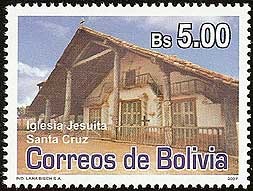
2008, the Jesuit Churches of Santa Ana and of San Javier, Santa Cruz, Scott 1372-1373In the Chiquitos region of the Department of Santa Cruz in Bolivia east of the Department's capital city, Santa Cruz de la Sierra, the Jesuits founded missions to evangelize the indigenous Chiquitanos to Christianity. They are so called because the natives lived in houses with low doorways (chiquito means small). Six of the ten Jesuit mission churches in the area have been restored and were recognized in 1991 by UNESCO as part of the Cultural Patrimony of Humanity.
The 5.00 bolivianos value shows the Jesuit church of Santa Ana, the most remote church of the circuit, which has the most original architecture intact from the colonial era. It is less decorated than the other churches, covered with a layer of putty-colored paint. It was founded in 1755 by Fr. Julián Nogler, SJ. The only decorations on its façade are six twisted columns that do not meet the roof.
The 9.00 bolivianos value shows the Jesuit church in San Javier. This mission was the first of the Chiquitos reductions to be founded by Fr. José Francisco de Arce, SJ and Brother Antonio de Rivas, SJ on the last day of 1691. The church was-built between 1749 and 1752, and restored between 1987 and 1993. It is a prototypical example of Chiquitos architecture, with its sweeping, wide eaves and its brightly colored Baroque façade.
